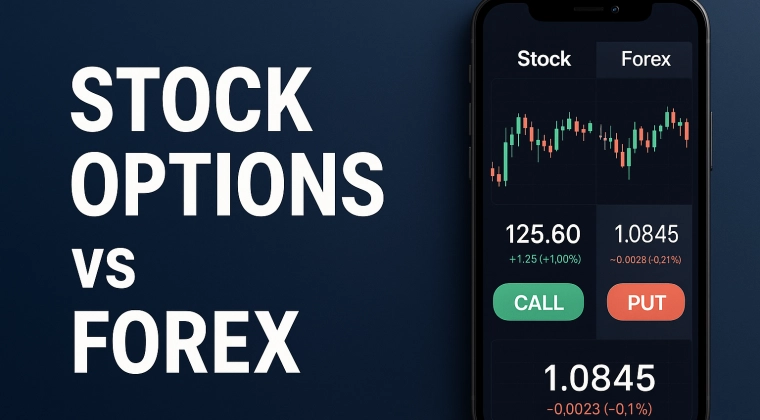
ดาวน์โหลดแอป
-
- แพลตฟอร์มการเทรด
- แอป PU Prime
- MetaTrader 5
- MetaTrader 4
- PU Copy Trading
- ซื้อขายบนเว็บ
- PU โซเชียล

ดาวน์โหลดแอป

If you’re looking to get into trading, two of the most popular markets you’ll come across are stock options and forex.
Both let you speculate on price movements, but they work very differently, and knowing which one suits you comes down to your goals, risk tolerance, and how hands-on you want to be.
Whether you’re just starting or considering a new venture, this guide will break down the key differences, enabling you to choose with greater confidence.
Stock options give you the right, but not the obligation, to buy or sell a specific stock at a fixed price before a set date.
You’re not buying the stock itself; you’re trading on its potential to move up or down.
Here’s how it works:
If the stock price moves in your favour, your option could become valuable.
If it doesn’t, the contract may expire worthless, and you lose the premium you paid.
Options trading can be used to speculate on price swings or to hedge other investments in your portfolio; it all depends on how you want to use it.
Forex trading is the act of exchanging one currency for another, and it happens in the largest and most liquid financial market in the world.
It’s fast-paced, accessible, and runs nearly 24 hours a day.
Here’s what you need to know:
Most forex trading happens through online platforms or brokers, and it’s popular among both beginners and experienced traders because of its flexibility and global scope.
| Stock options | Forex | |
| What you’re trading | Contracts based on company shares | Currency pairs (like EUR/USD or GBP/JPY) |
| Do you own the asset? | No, you’re trading a contract, not the stock itself | No, you’re speculating on exchange rate changes, not holding real currency |
| When can you trade? | During exchange hours; each option has an expiry date | Almost 24 hours a day, 5 days a week |
| How liquid is the market? | Liquidity varies depending on the stock | Very high, especially with major currency pairs |
| Can you use leverage? | Yes, but it’s often limited and more tightly regulated | Yes, usually with higher leverage options available |
| How easy is it to get started? | Usually requires a broker and some extra approval | Easier to access with most standard trading accounts |
| Risk management tools | Built-in strategies like hedging can help manage risk | Risk tools depend on your strategy and platform features |
In short, stock options offer more complex strategy choices and can be great for hedging if you know what you’re doing.
Forex is fast-moving, accessible, and ideal for those who want flexibility and global exposure.
The best fit depends on your trading preferences and the level of hands-on involvement you prefer.
There’s no one-size-fits-all strategy in forex.
The market runs almost around the clock, allowing traders to use a range of styles depending on their comfort level with time and risk.
Many forex traders combine charts, technical tools, and economic news to shape their decisions.
Spot trading, where trades are settled almost instantly, is especially common for those chasing short-term price changes.
Options trading opens the door to all kinds of strategic setups.
Because you’re trading contracts instead of actual shares, you can customise how much risk and reward you’re willing to take on.
Each strategy suits a different outlook and level of risk tolerance.
Some require more capital upfront, while others offer big upside potential if you get the direction and timing right.
But like all trading, options come with risk, especially if you’re not keeping a close eye on how your trades are set up.
Planning and understanding your strategy matter as much as the trade itself.
Trading forex or stock options can offer big opportunities, but they also come with real risks.
Understanding what you’re getting into is just as important as knowing how to trade.
Whether you’re trading currencies or options, remember: you’re speculating on price movements.
You don’t own the actual currency or shares, and losses are possible, sometimes even greater than your original investment.
Always know your limits, use risk management tools, and only trade what you can afford to lose.
Here’s how stock options and forex stack up, depending on what matters most to you:
| Feature | Stock options | Forex trading |
| Liquidity | Moderate, depends on the stock and option activity | Very high, especially with major currency pairs |
| Market hours | Limited to exchange hours | Nearly 24 hours a day, five days a week |
| Leverage | Available, but more tightly regulated | High leverage is more common |
| Complexity | Higher, lots of jargon and contract details to understand | Moderate, needs focus, but more straightforward than options |
| Flexibility | Wide range of strategies, including advanced setups like spreads | Good for fast moves, but fewer strategic combinations |
| Ownership | No actual ownership of the stock | No actual ownership of the currency |
| Accessibility | May require extra approval from your broker | Easy to access through most online platforms |
| Built-in safety net | Some strategies (like protective puts) help manage risk | Risk must be managed manually through stop-loss and position sizing |
The bottom line is that Forex is generally more accessible and faster-paced, making it appealing for beginners.
Stock options offer more structure and strategic depth, especially for managing risk, but they come with a steeper learning curve.
The best choice depends on how much control, complexity, and time you’re comfortable with.
Choosing between stock options and forex really comes down to how you like to trade and how much time and risk you’re willing to take on.
There’s no one right answer, just what works best for you.
Both markets take time to learn, and both reward careful planning and risk management.
The first step? Find a trading platform that supports your learning curve and lets you practise safely.
PU Prime offers a flexible platform where you can trade forex and CFDs with real-time data, risk tools, and even a demo account to practise first.
It’s a smart way to get started, without jumping in blind.
Do I actually own shares or currency when I trade options or forex?
No. With stock options, you’re buying the right to trade shares at a set price, not the shares themselves. In forex, you’re speculating on currency values without holding the actual currency.
Which market is bigger: stocks or forex?
The forex market is much larger in terms of daily trading volume.
It runs almost nonstop and is known for being the most liquid financial market in the world.
Is forex trading riskier than options trading?
Both carry risk, just in different ways. Forex is fast-moving and heavily leveraged.
Options can be complex and time-sensitive, especially if a trade doesn’t go your way before expiry.
The key is understanding what you’re trading and having a plan.
Can I trade forex or options from anywhere?
Yes. Both markets are available online, as long as you’re using a regulated broker.
Platforms like PU Prime offer access to both through a single account, along with tools to manage trades and track performance.
Can I lose more than I put in?
Yes, especially if you’re using leverage or writing uncovered option contracts.
It’s important to use stop-loss orders, manage position sizes, and never trade money you can’t afford to lose.

ซื้อขายฟอเร็กซ์ ดัชนี โลหะ และอื่น ๆอีกมากมายที่ค่าสเปรดต่ำในอุตสาหกรรม และการดำเนินการที่รวดเร็วปานสายฟ้าแลบ
ลงทะเบียนบัญชีจริงของ PU Prime ด้วยกระบวนการที่ปราศจากความยุ่งยากของเรา
โอนเงินเข้าบัญชีของคุณได้อย่างง่ายดายด้วยช่องทางที่หลากหลาย และสกุลเงินที่ยอมรับได้
เข้าถึงตราสารหลายร้อยรายการภายใต้เงื่อนไขการซื้อขายชั้นนำของตลาด

Please note the Website is intended for individuals residing in jurisdictions where accessing the Website is permitted by law.
Please note that PU Prime and its affiliated entities are neither established nor operating in your home jurisdiction.
By clicking the "Acknowledge" button, you confirm that you are entering this website solely based on your initiative and not as a result of any specific marketing outreach. You wish to obtain information from this website which is provided on reverse solicitation in accordance with the laws of your home jurisdiction.
Thank You for Your Acknowledgement!
Ten en cuenta que el sitio web está destinado a personas que residen en jurisdicciones donde el acceso al sitio web está permitido por la ley.
Ten en cuenta que PU Prime y sus entidades afiliadas no están establecidas ni operan en tu jurisdicción de origen.
Al hacer clic en el botón "Aceptar", confirmas que estás ingresando a este sitio web por tu propia iniciativa y no como resultado de ningún esfuerzo de marketing específico. Deseas obtener información de este sitio web que se proporciona mediante solicitud inversa de acuerdo con las leyes de tu jurisdicción de origen.
Thank You for Your Acknowledgement!